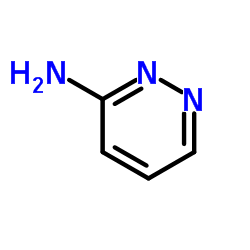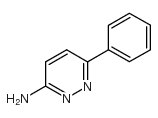88497-27-2
| 中文名 | 6-溴-3-吡嗪胺 |
|---|---|
| 英文名 | 3-Amino-6-bromopyridazine |
| 中文别名 |
3-氨基-6-溴哒嗪
3-氨基-6-溴吡嗪 |
| 英文别名 |
3-Pyridazinamine, 6-bromo-
6-bromopyridazin-3-amine 6-Bromo-3-pyridazinamine MFCD01646092 |
| 密度 | 1.8±0.1 g/cm3 |
|---|---|
| 沸点 | 353.2±22.0 °C at 760 mmHg |
| 熔点 | 194ºC |
| 分子式 | C4H4BrN3 |
| 分子量 | 173.999 |
| 闪点 | 167.4±22.3 °C |
| 精确质量 | 172.958847 |
| PSA | 51.80000 |
| LogP | 0.98 |
| 蒸汽压 | 0.0±0.8 mmHg at 25°C |
| 折射率 | 1.649 |
| 储存条件 | 室温,干燥,密封 |
| 分子结构 | 1、 摩尔折射率:34.36 2、 摩尔体积(cm3/mol):94.3 3、 等张比容(90.2K):271.8 4、 表面张力(dyne/cm):68.9 5、 极化率(10-24cm3):13.62 |
| 计算化学 | 1.疏水参数计算参考值(XlogP):无 2.氢键供体数量:1 3.氢键受体数量:3 4.可旋转化学键数量:0 5.互变异构体数量:2 6.拓扑分子极性表面积51.8 7.重原子数量:8 8.表面电荷:0 9.复杂度:77.7 10.同位素原子数量:0 11.确定原子立构中心数量:0 12.不确定原子立构中心数量:0 13.确定化学键立构中心数量:0 14.不确定化学键立构中心数量:0 15.共价键单元数量:1 |
| 更多 | 1. 熔点(ºC):194 |
Synonym:6-Bromo-3-pyridazinylamine Section 2 - COMPOSITION, INFORMATION ON INGREDIENTS
Risk Phrases: 36/37/38 Section 3 - HAZARDS IDENTIFICATION EMERGENCY OVERVIEW
Irritating to eyes, respiratory system and skin. Potential Health Effects Eye: Causes eye irritation. May cause chemical conjunctivitis. Skin: Causes skin irritation. May be harmful if absorbed through the skin. Ingestion: May cause irritation of the digestive tract. May be harmful if swallowed. Inhalation: Causes respiratory tract irritation. May be harmful if inhaled. Chronic: No information found. Section 4 - FIRST AID MEASURES Eyes: Immediately flush eyes with plenty of water for at least 15 minutes, occasionally lifting the upper and lower eyelids. Get medical aid. Skin: Get medical aid. Flush skin with plenty of water for at least 15 minutes while removing contaminated clothing and shoes. Wash clothing before reuse. Ingestion: Never give anything by mouth to an unconscious person. Get medical aid. Do NOT induce vomiting. If conscious and alert, rinse mouth and drink 2-4 cupfuls of milk or water. Wash mouth out with water. Inhalation: Remove from exposure and move to fresh air immediately. If not breathing, give artificial respiration. If breathing is difficult, give oxygen. Get medical aid. Notes to Physician: Treat symptomatically and supportively. Section 5 - FIRE FIGHTING MEASURES General Information: As in any fire, wear a self-contained breathing apparatus in pressure-demand, MSHA/NIOSH (approved or equivalent), and full protective gear. During a fire, irritating and highly toxic gases may be generated by thermal decomposition or combustion. Extinguishing Media: Use water spray, dry chemical, carbon dioxide, or chemical foam. Section 6 - ACCIDENTAL RELEASE MEASURES General Information: Use proper personal protective equipment as indicated in Section 8. Spills/Leaks: Vacuum or sweep up material and place into a suitable disposal container. Clean up spills immediately, observing precautions in the Protective Equipment section. Avoid generating dusty conditions. Provide ventilation. Section 7 - HANDLING and STORAGE Handling: Minimize dust generation and accumulation. Avoid breathing dust, vapor, mist, or gas. Avoid contact with eyes, skin, and clothing. Keep container tightly closed. Avoid ingestion and inhalation. Use with adequate ventilation. Wash clothing before reuse. Storage: Store in a cool, dry place. Store in a tightly closed container. Section 8 - EXPOSURE CONTROLS, PERSONAL PROTECTION Engineering Controls: Facilities storing or utilizing this material should be equipped with an eyewash facility and a safety shower. Use adequate ventilation to keep airborne concentrations low. Exposure Limits CAS# 88497-27-2: Personal Protective Equipment Eyes: Wear appropriate protective eyeglasses or chemical safety goggles as described by OSHA's eye and face protection regulations in 29 CFR 1910.133 or European Standard EN166. Skin: Wear appropriate protective gloves to prevent skin exposure. Clothing: Wear appropriate protective clothing to prevent skin exposure. Respirators: Follow the OSHA respirator regulations found in 29 CFR 1910.134 or European Standard EN 149. Use a NIOSH/MSHA or European Standard EN 149 approved respirator if exposure limits are exceeded or if irritation or other symptoms are experienced. Section 9 - PHYSICAL AND CHEMICAL PROPERTIES Physical State: Solid Color: beige Odor: Not available. pH: Not available. Vapor Pressure: Not available. Viscosity: Not available. Boiling Point: Not available. Freezing/Melting Point: 203-207 deg C Autoignition Temperature: Not available. Flash Point: Not available. Explosion Limits, lower: Not available. Explosion Limits, upper: Not available. Decomposition Temperature: Solubility in water: Specific Gravity/Density: Molecular Formula: C4H4BrN3 Molecular Weight: 174 Section 10 - STABILITY AND REACTIVITY Chemical Stability: Stable at room temperature in closed containers under normal storage and handling conditions. Conditions to Avoid: Dust generation. Incompatibilities with Other Materials: Oxidizing agents, acids, acid chlorides. Hazardous Decomposition Products: Carbon monoxide, oxides of nitrogen, carbon dioxide, hydrogen bromide, bromine. Hazardous Polymerization: Has not been reported Section 11 - TOXICOLOGICAL INFORMATION RTECS#: CAS# 88497-27-2 unlisted. LD50/LC50: Not available. Carcinogenicity: 6-Bromo-3-pyridazinamine - Not listed by ACGIH, IARC, or NTP. Section 12 - ECOLOGICAL INFORMATION Section 13 - DISPOSAL CONSIDERATIONS Dispose of in a manner consistent with federal, state, and local regulations. Section 14 - TRANSPORT INFORMATION IATA Shipping Name: Not regulated. Hazard Class: UN Number: Packing Group: IMO Shipping Name: Not regulated. Hazard Class: UN Number: Packing Group: RID/ADR Shipping Name: Not regulated. Hazard Class: UN Number: Packing group: Section 15 - REGULATORY INFORMATION European/International Regulations European Labeling in Accordance with EC Directives Hazard Symbols: XI Risk Phrases: R 36/37/38 Irritating to eyes, respiratory system and skin. Safety Phrases: S 22 Do not breathe dust. S 26 In case of contact with eyes, rinse immediately with plenty of water and seek medical advice. S 36/37/39 Wear suitable protective clothing, gloves and eye/face protection. WGK (Water Danger/Protection) CAS# 88497-27-2: No information available. Canada None of the chemicals in this product are listed on the DSL/NDSL list. CAS# 88497-27-2 is not listed on Canada's Ingredient Disclosure List. US FEDERAL TSCA CAS# 88497-27-2 is not listed on the TSCA inventory. It is for research and development use only. SECTION 16 - ADDITIONAL INFORMATION N/A |
| 危害码 (欧洲) | Xn |
|---|---|
| 风险声明 (欧洲) | 20/21/22-36/37/38 |
| 安全声明 (欧洲) | 22-26-36/37/39 |
| 危险品运输编码 | 2811 |
|
~75% 
88497-27-2 |
| 文献:BAYER PHARMA AKTIENGESELLSCHAFT; SIEMEISTER, Gerhard; BADER, Benjamin; WENGNER, Antje, Margret; MUMBERG, Dominik; KOPPITZ, Marcus; KLAR, Ulrich; KROEMER, Guido; VITALE, Ilio; JEMAÀ, Mohamed Patent: WO2014/20041 A1, 2014 ; Location in patent: Page/Page column 137 ; |
| 上游产品 1 | |
|---|---|
| 下游产品 3 | |





